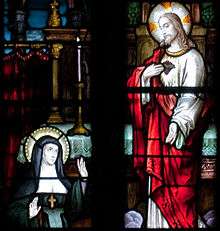Our Lady of La Salette
Our Lady of La Salette (French: Notre-Dame de La Salette) is a Marian apparition reported by two children, Maximin Giraud and Mélanie Calvat[3] to have occurred at La Salette-Fallavaux, France, in 1846.
| Our Lady of La Salette | |
|---|---|
| Location | La Salette-Fallavaux, France |
| Date | 19 September 1846 |
| Witness | Mélanie Calvat Maximin Giraud |
| Type | Marian apparition |
| Approval | September 19, 1851[1][2] Bishop Philibert de Bruillard Diocese of Grenoble |
| Shrine | Sanctuary of Our Lady of La Salette, La Salette, France |
| Patronage | La Salette-Fallavaux, Silang, Cavite |
| Part of a series on the |
| Mariology of the Catholic Church |
|---|
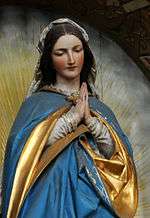 Virgo by Josef Moroder-Lusenberg |
|
|
|
|
|
|
On 19 September 1851, the local bishop formally approved the public devotion and prayers to Our Lady of La Salette.[2][1] On 21 August 1879, Pope Leo XIII granted a canonical coronation to the image now located within the Basilica of Our Lady of La Salette. A Russian style tiara was granted to the image, instead of the solar-type tiara used in its traditional depictions of Our Lady during her apparitions.
Places dedicated to Our Lady of La Salette outside of France include a sanctuary in Oliveira de Azeméis, in Portugal; shrines in Enfield, New Hampshire, and Attleboro, Massachusetts in the United States, both known for their Christmas lights; and a chapel in San Miguel de Allende, Guanajuato, in México.
History
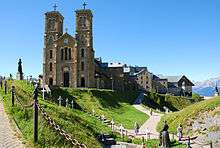
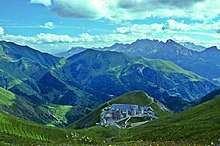
In 1846 the village of La Salette consisted of eight or nine scattered hamlets. The population was about 800, principally small farmers with their families and dependents. On the evening of Saturday, 19 September 1846, Maximin Giraud and Mélanie Calvat (called Mathieu[4]) returned from the mountain where they had been minding cows and reported seeing "a beautiful lady" on Mount Sous-Les Baisses, weeping bitterly. They described her as sitting with her elbows resting on her knees and her face buried in her hands. She was clothed in a white robe studded with pearls; and a gold colored apron; white shoes and roses about her feet and high headdress. Around her neck she wore a crucifix suspended from a small chain.[5]
According to their account, she continued to weep even as she spoke to them, first in French, then in their own dialect[6] of Occitan.[7] After giving a secret to each child, the apparition walked up a hill and vanished.
After five years of investigation, the Bishop of Grenoble, Philibert de Bruillard announced in 1851 that the apparition was likely to be a true revelation and authorised the commencement of the following of Our Lady of La Salette.[8] This determination was later confirmed by his successor, Bishop Ginoulhiac.[9]
Message
According to the children's account, the Virgin invited people to respect the repose of the seventh day, and to respect the name of God. She sorrowfully threatened punishment, in particular a scarcity of potatoes, which would rot. The context of these punishments places the warning just prior to the winter of 1846–1847, which was in Europe, and especially in France and in Ireland, a period of famine in the months which followed the apparition. This was one of the factors of the apparition's popular appeal.[3]
The message of the visionaries of La Salette focuses on the conversion of all humanity to Christ. John Vianney, John Bosco, and writer Joris-Karl Huysmans were all influenced by La Salette. The spirit of La Salette is said to be one of prayer, conversion, and commitment.[10] Fr. René J. Butler, M.S. of the La Salette Missionaries of North America says "The whole purpose of the Apparition of Our Lady of La Salette was reconciliation."[11]
Pope John Paul II stated: "As I wrote on the occasion of the 150th anniversary, 'La Salette is a message of hope, for our hope is nourished by the intercession of her who is the Mother of mankind."[12]
Inquiry
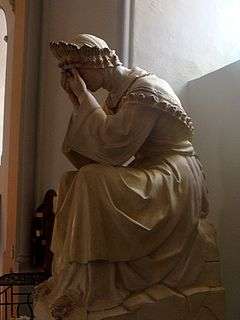
Sensation about Our Lady of La Salette arose when Mélanie and Maximin made their message public, which caused the bishop of Grenoble to investigate the apparition. During the investigation, a number of accusations were made against the visionaries, including the assertion that the apparition was actually just a middle-aged woman named La Merlière.[4]
Secrets
No mention of secrets is made in the children's first accounts, presumably out of fear they would be compelled to disclose them. The children later reported that the Blessed Virgin had confided a special secret to each of them. These two secrets, which neither Mélanie nor Maximin ever made known to each other, were sent by them in 1851 to Pope Pius IX on the advice of Mgr. de Bruillard.[4][13] It is assumed that these secrets were of a personal nature. Maximin advised the Marquise de Monteyard, "Ah, it is good fortune."[14]
Fate of the children
Maximin Giraud, after an unhappy and wandering life, returned to Corps (Isère), his native village, and died on 1 March 1875 before turning 40. Mélanie Calvat died as a Catholic nun at Altamura, Italy, on 15 December 1904.[4]
Legacy

The Missionaries of Our Lady of La Salette were founded in 1852 by Bp. Philbert de Bruillard, Bishop of Grenoble, France, and presently serve in some 25 countries.[15]
The National Shrine of Our Lady of La Salette is located in Attleboro, Massachusetts. Known simply as "La Salette" locally, it is famous for its Festival of Lights, held annually during the Christmas season, where the grounds are decorated with elaborate Christmas light displays.[16]
See also
References
- "History of La Salettes". Missionaries of Our Lady of La Salette. 26 April 2013. Retrieved 11 October 2019.
1851 … Bishop de Bruillard publishes the Doctrinal Statement of September 19: the Apparition is authentic; public worship is authorized; a church will be built on the site of the Apparition.
- "Excerpts from The Pastoral Letter of Mgr de Bruillard, Bishop of Grenoble, on the Fifth Anniversary of the La Salette Apparition". Miracle Hunter. 19 September 1851. Retrieved 11 October 2019.
We judge that the Apparition of the Blessed Virgin to the two cowherds on the 19th of September, 1846, on a mountain of the chain of Alps, situated in the parish of LaSalette, in the archpresbytery of Corps, bears within Itself all the characteristics of truth, and that the faithful have grounds for believing it indubitable and certain.
- "Marian Apparitions". University of Dayton. Archived from the original on 15 March 2013. Retrieved 23 November 2013.
- Clugnet, Léon (1910). La Salette. The Catholic Encyclopedia. 9. New York: Robert Appleton Company. Retrieved 3 February 2014.
- Wyse, John. Manual of the Confraternity of LaSalette, London, Richardson and Son, 1855, p. 9
- Stern, Jean. 1980. La Salette, Documents authentiques. Part 1. Paris: Desclée De Brouwer, pp. 66, 71, [about the dialect itself] 279–280.
- Bert, Michael and James Costa. 2010. "Linguistic borders, language revitalisation and the imagining of new regional entities Archived 20 October 2012 at the Wayback Machine", Borders and Identities Archived 19 October 2012 at the Wayback Machine (Newcastle upon Tyne, 8–9 Jan 2010), p. 18.
- "Notre-Dame de La Salette", Eymardian Places
- Bunson, Matthew. "LaSalette", Catholic Almanac's Guide to the Church Our Sunday Visitor, 2001, ISBN 9781612781754
- Castel, R. (1985). La Salette. Dictionary of Mary. New York: Catholic Book Publishing Company. Archived from the original on 3 October 2012. Retrieved 24 October 2012.
- "Butler M.S., René. "Feast of Our Lady of La Salette"". Archived from the original on 20 September 2017. Retrieved 19 September 2017.
- "Address of the Holy Father John Paul II to the Missionaries of Our Lady of La Salette". Libreria Editrice Vaticana. 4 May 2000. Retrieved 23 November 2013.
- Bourmaud, Fr. Dominique (July–December 2003). "Discovery of the Secret of La Salette". Newsletter of District of Asia. Society of St. Pius X District of Asia. Retrieved 23 November 2013.
- Zimdars-Swartz, Sandra L., Encountering Mary: From La Salette to Medjugorje, Princeton University Press, 2014 ISBN 9781400861637
- "La Salette – A Universal Mission", Les Annales, Jan–Feb, 2011, pgs. 18–19
- National Shrine of Our Lady of La Salette
